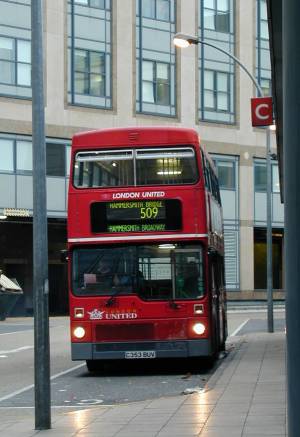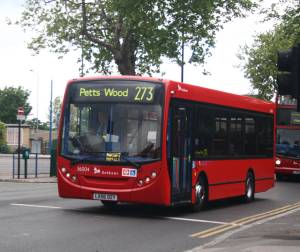 Over the past few weeks, my local bus operator Travel London (West) – formerly known as Tellings-Golden Miller – has been re-equipping its Byfleet-based fleet of Dennis Dart SLFs with LED blinds. DP 703 (R503 SJM) is just the latest example, and it’s sure to kick off a debate in these pages that I hope will be as involved as that set off by my mention of Metroline a few posts back.
Over the past few weeks, my local bus operator Travel London (West) – formerly known as Tellings-Golden Miller – has been re-equipping its Byfleet-based fleet of Dennis Dart SLFs with LED blinds. DP 703 (R503 SJM) is just the latest example, and it’s sure to kick off a debate in these pages that I hope will be as involved as that set off by my mention of Metroline a few posts back.
Most operators around the country have adopted LED blinds as standard, especially since the technology has improved considerably from the first generation of vulnerable and error-prone flip-dot displays, via dot-matrix panels that were subject to the same vulnerabilities, to today’s versatile units that seem to be programmable with just about anything, and which, most importantly for the photographer, don’t just reproduce as two unintelligible single lines. It’s not just the enthusiast who found this a nuisance – think of publicity photographs for operators and the manufacturers, who would be looking pretty daft with their products showing themselves up this way. The previous generation of LED panels would not show at shutter speeds above 1/60, which ruled out pictures in any level of sunshine! Even so, I’ve always kept my camera on burst mode, so that out of a round of five shot off, one would work. This picture shows that the blinds displaying satisfactorily were the least of my worries (despite the fogged glass panel) – there was a lot more traffic than you’d expect for a Saturday morning and I had to shoot through it.
Transport for London, of course, have a different way of going about things. They don’t, and don’t intend to, adopt LED blind technology on their contractors’ vehicles. Given that the standard of blind display since the secretive and highly intransigent ‘BBC’ (Bus Blinds Committee) have come into being is totally inadequate to the point of negligence, with no via points allowed and just a destination (without the benefit of any qualifiers) expected to offer passengers what they need to find out, this is inexplicable. I may be something of a traditionalist, but I’ll declare myself a big fan of the latest LED panels – TfL don’t know what they’re missing and are mad to write off the possibilities this technology offers. For instance, even though this 461 just displays ‘Kingston’, other boards for the 218 in the same region display ‘Kingston’, with ‘via Esher, Walton-on-Thames, Shepperton and Laleham’ scrolling by leisurely underneath. It’s all legible, and from a considerably greater distance (especially at night) – and since I’ve had lousy eyesight since I was born, surely I have a better claim on what is legible and what isn’t.
There’s great potential in this. With GPS technology already coming into play for the successor to Countdown (known as iBus), is that once the bus crosses a point on the route the system can knock out the appropriate via point from the display, thus nullifying one of the objections to via points. Buses can also display them in the opposite direction, without the need for expenditure on linen (or Tyvec); since operators never seem to trust drivers to change the blinds anyway (and the unions reluctant to let them without a little something in return), all this doesn’t even need to be done at the push of a button. You can even have different colours for route numbers, like the panels on buses in Reading.
So give it a try, TfL. I have a feeling that in ten years or so all London buses will have LED displays.
 Yes, the Metrobus is a London bus.
Yes, the Metrobus is a London bus.




